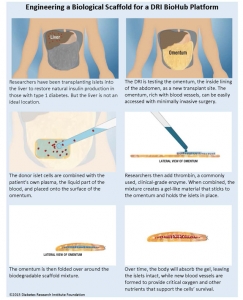Much of the research for diabetes as a disease involves digital innovations such as fast and accurate meters, online recording systems or continuous monitoring and delivery meters. But many see these as a stop gap until the ‘holy grail’ of diabetes is achieved: an intervention to replace insulin production. Sometimes the best treatment can involve replacing or bypassing these digital innovations.
Successful trials have been announced by The Diabetes Research Institute (DRI) at the University of Miami Miller School of Medicine. They have successfully implanted islet cells held by a biological scaffold which are now producing insulin independently.
Previously, trials have attempted to place islet cells on the liver, where they would normally be produced by the body, but their survival has not been successful. This procedure takes islet cells and implants them in the omentum, which is highly vascularized tissue covering abdominal organs. A scaffold to hold them in place is a gel composed of the patient’s blood plasma and an enzyme, thrombin. Over time this is absorbed by the body, leaving the cells implanted, round which new blood vessels form.

The full article is detailed here and more here.



